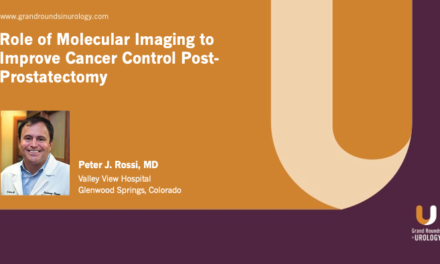Dr. Mark Emberton spoke at the 25th International Prostate Cancer Update on Thursday, January 22, 2015 on “Targeted Focal Therapy – Promise and Progress.”
Keywords: targeted focal therapy, prostate cancer, MRI, lesion, treatment.
How to cite: Emberton, Mark. “Targeted Focal Therapy – Promise and Progress” Grand Rounds in Urology. June 18, 2015. Accessed Jan 2025. https://dev.grandroundsinurology.com/prostate-cancer-mark-emberton-targeted-focal-therapy/.
Transcript
Targeted Focal Therapy – Promise and Progress
Atul Gawande really echoes what we’ve just heard and just reminds us that the unrelenting quest for improvement never stops and this is in a sense a response to that. That response these days is a multidisciplinary exercise. This isn’t a 25-year-old photograph; it’s a 10-year-old photograph and none of us have aged particularly well. But you can see here that there’s a mixture of clinicians, funders, engineers and very importantly imaging experts who all got together to address some of the unmet need and come up with a new class of therapy.
Like most things, one stumbled across it. One didn’t intend or design this treatment in the late 90s, early 2000s when 0.5 Tesla scanners were available and we copied what the neurosurgeons were doing by injecting gadolinium on some of the phase I studies. We could see that it was possible to selectively ablate prostatic tissue. Really that was the go to the various developments that have happened since.
I think the key thing that has changed everything, the revolution, is this transition from not knowing where the tumor is to knowing where the tumor is. The information on this slide would allow me to communicate to somebody outside of this room that this man has a 0.4 cc lesion situated within the peripheral zone exhibiting 5 mm capture abutment sitting between 6 and 7 o’clock, having picked up a blood supply on the gadolinium scan and would be very likely to contain some elements of pattern 4.
One couldn’t do that before. One would have to wait until the radical prostatectomy had been done and the histopathology had been reviewed to communicate that degree of precision to a third party. We can now do it by using images. That’s the revolution. I don’t think we’ve truly, truly grasped how big this revolution is and that we’ve been treating prostate cancer for 100 years or just over 100 years if Hugh Hampton Young was the first, blind to the tumor location and that is now changed.
The other thing that’s changed s the conceptual framework in which we work. Like most things, skepticism is an appropriate response to new ideas and new technology. This was a very difficult thing to persuade others that it was worth doing. This was really about 7-8 years ago. It’s interesting to reflect just how much things have changed. It hasn’t been an easy ride, but we’ve already heard today from about 4 or 5 speakers that they believe that focal therapy will have a role in some patients in the future. That’s the first time I’ve heard so many people say that.
Patrick Walsh was very skeptical to this study that was published in Lancet Oncology. He was very disappointed that the Lancet Journal would permit the authors to conclude that these patients were actually free of disease and for the authors–that’s me and a few other people–to fool the public into believing it.
He’s changed too. He debated with Hashim Ahmed in L.A. a year ago and I think it was a safe draw. He was very generous in his comments to Hashim Ahmed and very complementary about the work and the accumulation of evidence to support this idea. That’s being reflected in response to grant applications now that are coming back from grant-giving agencies not just in the U.K., but from around the world.
The conceptual framework is changing. We now have freedom to operate. It’s now really about developing the ideas and the good trials that can recruit so that we can take things forward.
The evidence has been put together by Massimo Valerio. It’s not great. It’s mostly single-center series that allow us to look at issues relating to toxicity. In all but a few studies the oncological outcome has been derived really rather early. We only have real data up to about a year, but at least this gives us a framework from which to go on. Anybody who wants to read, all these studies can because they’ve been summarized for you now.
I think the other thing that’s changing is the work from other authors that are allowing us to treat in a selective manner, in other words to identify a target and apply treatment to it and not treat the rest of the gland as we’ve done in the kidney and indeed in penile cancer.
This was published just a couple of months ago. A randomized study of 1,200 men who had MRI versus a standard approach to diagnosis. It was a very, very difficult paper to read, as you can see from this algorithm, but I’ve done the work for you. These are the results. If you do an MRI-based diagnostic study, your yield in terms of cancer diagnosis is twice that if you use a transrectal-base study. Most randomized studies are designed to detect 10% difference. Here we have 100% difference in terms of the yield.
What I was interested in and deep, deep, deep in the study is what happens when the MRI was negative, when men were randomized to MRI first and the MRI was negative. This group did very, very detailed saturation biopsies of that group. This was the astonishing result.
In case anybody’s unclear about what none means, I put the percentage there. It’s very rare to see a zero in any scientific paper, and 130 of the men that had a negative MRI and had detailed sampling none of them, 0%, had any pattern 4 or 5 within their prostate. Nothing’s going to be 0, but it gives us some idea of what might be possible and how we might use MRI to decide what not to treat in terms of the presence or absence of clinically significant disease.
I’d be skeptical if this was the only study. Rotterdam showed exactly the same against radical prostatectomy this time. If the MRI was normal, PI-RADS 1 and 2, 0% of the men had any pattern 4 or 5 within their prostate.
This gives us some inclination that we might be able to use imaging not only to decide what to treat, but also to decide what not to treat. This is just the parallel accumulation of evidence that is allowing us to proceed to the next phase.
The other relates to this notion of the entity that we wish to treat, the so-called index lesion. I think our colleagues are also helping us in this domain as well. This paper again was published just a couple of months ago. It just shows how contemporary most of these changes are. What they did, they looked at four cases and they identified low risk lesions, as I’ve shown you there, high risk lesions, and a metastasis when a metastasis was available. These are the other two cases. Low risk lesions, BPH, and high risk lesions in this group.
What was fascinating is that they looked at carefully the somatic mutations. The somatic mutations in the low risk lesions were private to those low risk lesions as I’ll illustrate here compared to the high risk zlesions which shared a lot of mutations with the metastasis, in this case as you can see here. No homology at all between low risk and high risk. Very close homology between high risk metastases.
I’ll go through these quickly because they’re all the same. Completely private here. Completely private here. Three mutations were shared in this case. A few more mutations shared in this case, but nowhere near the mutations that were shared between the high risk lesion and the metastatic lesion, allowing us at least to postulate that the low risk lesion is quite distinct from the R target of treatment that we are after in selective therapy.
The other thing to know, it is the branching here. The conclusion to this study was that the pattern mutations are consistent with the early divergence between low and high-grade foci. These are separate entities that diverge very, very early in the natural history, but late divergence between high grade foci and metastases. It’s the high grade foci that we’re after. It looks as though low grade foci may not require our attention, as they are a different animal.
This really supports work from others. I think Lauri Klotz showed this slide early on or a different version of this paper suggesting that the evidence is supporting a clonal hypothesis of development, rather than a transitional hypothesis. In other words, Gleason 4 and 5 isn’t born from 3; it’s born separately. This obviously would allow the focal therapy paradigm to develop.
In other words, this is image-based pathway and I hope you can see these reasonably well. This is a lesion high up between 11 and 12 o’clock on the prostate showing positivity on all these sequences. If we chase the lesions that we see on imaging, it’s very likely that they come up with the kind of disease that we would consider clinically significant. That lesion, three of the four cores dedicated to it, were positive, 10 mm maximum cancer core length, 3+4 with pattern 4 representing 25% of the volume. We might choose to watch that lesion. We might choose in the future to treat it.
We can rely on the negative component of the MRI to be relatively sure that no clinically significant disease exists there, allowing at least an idea of selective therapy to progress.
The lesions that we’re identifying using a modern diagnostic pathway seemed to have the attribute so the kind of clinically significant disease that we are after. We can now find out even more about these lesions. Scott Lucia at the beginning of today said it was impossible to define the temporal stability of these lesions. We had to use predictors. He’s wrong. I’ll show you why. This study hasn’t been published. It’s been presented and we’re just preparing the manuscript. Randomized trial of lesions within the prostate watched very carefully over a six-month period. This is the placebo-treated patient which had lesional stability over six months. This is a man randomized to placebo whose lesion grew over six months–in other words, progressed. This is a patient who was randomized to dutasteride whose lesion had a 50% reduction in volume. This was a responder to the treatment arm.
The key slide is this. Just by seeing a lesion and just allowing a six-month window, you can segment the population into progressors. Here are men randomized to placebo who exhibited 100% increase in tumor volume over six months versus these that just stayed very stable. These were obviously treated, but interestingly, some of the placebo-treated men, the volume actually went down with time. Interestingly, some of the treated men didn’t seem to respond to the treatment.
It may be that once our lesion is identified, we can actually watch it and let the phenotype play out, rather than having to do the complex process of prediction. You would treat these guys and you might continue to observe these guys. This is a model that would allow us to understand the genetic and epigenetic aspects of disease much more clearly. We can use the interval to identify the progressors versus the nonprogressors.
Over the years the first focal treatments were very conservative and it was appropriate to do that. They were anatomical. This treated a large lesion in the left-hand side within a clinical trial. You can see the complete anatomical hemi-ablation. The treatment wasn’t defined around the cancer, but around the prostate there at six months. We were able to show that the side effects were indeed minimal if we took out half the prostate.
The big discovery was that if you leave half the prostate alone, a virtual guarantee of return of urinary function and a 95% chance of getting your erections back within 6 months. The future is going to be towards much more selective therapy than that–I’ll just skip through that–and having treatments that are defined by the lesion and not by the anatomy.
I’ll just finish by showing you the sequence on this man with a lesion high up on the left between 12 and 1 o’clock about 0.5 cc in volume, and again, showing some pattern 4 on the targeted biopsies, 5 mm maximum cancer core length. He had a treatment. This time it was electroporation, but importantly defined around the tumor, rather than to the anatomy. Again, imaging was used to define treatment success at one week. You can see the ablated zone there on coronal and there indeed at six months. It may be that it will be imaging in this long B. This is the B2000, which is a very quick sequence that we will be able to use to followup.
I’ve just got my last slide here. The future I think we’ll see many, many new treatments come forward. One of our latest ones is using MRI of theranostic. In other words, we give ferromagnetic nanoparticles and use the MRI to take those particles around the body and use the MRI to shake up those particles to kill the target wherever in the body that might be.
In summary, a lot of you are now starting to do focal therapy. You can see we have to add dots to this quite frequently. We can summarize I think that we have a new class of therapy and I think we should be very lucky that it’s our profession that has hold of this class of therapy. I think we have legitimacy from certainly an academic component from harm-reduction component, a health economic component, if not a regulatory component quite yet.
Focal therapy has forced an order of precision that has hitherto been missing. If you’re going to treat at the whole gland level, you don’t care too much about where the cancer is because it’s all coming out or being treated anyway. If you’re leaving it behind, you have to have high levels of precision. We’ve asked great questions of our radiologists.
I think the important thing is that all the treatments so far have been modifications of old, existing therapies. What we’re going to see over the next five years are new therapies designed specifically for the task of focal therapy for men with localized prostate cancer. Some of the people developing those are in the room today. Thank you very much.
References
Ahmed HU . The index lesion and the origin of prostate cancer. N Engl J Med. 2009 Oct 22;361(17):1704-6.
http://www.ncbi.nlm.nih.gov/pubmed/19846858
Ahmed HU, Freeman A, Kirkham A, et al. Focal therapy for localized prostate cancer: a phase I/II trial. J Urol. 2011 Apr;185(4):1246-54.
http://www.ncbi.nlm.nih.gov/pubmed/21334018
Azzouzi AR, Barret E, Moore CM, et al. TOOKAD(®) Soluble vascular-targeted photodynamic (VTP) therapy: determination of optimal treatment conditions and assessment of effects in patients with localised prostate cancer. BJU Int. 2013 Oct;112(6):766-74.
http://www.ncbi.nlm.nih.gov/pubmed/24028764
Gawande A. Two hundred years of surgery. N Engl J Med. 2012 May 3;366(18):1716-23.
http://www.ncbi.nlm.nih.gov/pubmed/22551130
Lavery HJ, Droller MJ. Do Gleason patterns 3 and 4 prostate cancer represent separate disease states? J Urol. 2012 Nov;188(5):1667-75.
http://www.ncbi.nlm.nih.gov/pubmed/22998919
Panebianco V, Barchetti F, Sciarra A, et al. Multiparametric magnetic resonance imaging vs. standard care in men being evaluated for prostate cancer: a randomized study. Urol Oncol. 2015 Jan;33(1):17.e1-7.
http://www.ncbi.nlm.nih.gov/pubmed/25443268
Robertson NL, Moore CM, Ambler G, et al. MAPPED study design: a 6 month randomised controlled study to evaluate the effect of dutasteride on prostate cancer volume using magnetic resonance imaging. Contemp Clin Trials. 2013 Jan;34(1):80-9.
http://www.ncbi.nlm.nih.gov/pubmed/23085153
Valerio M, Ahmed HU, Emberton M, et al. The role of focal therapy in the management of localised prostate cancer: a systematic review. Eur Urol. 2014 Oct;66(4):732-51.
http://www.ncbi.nlm.nih.gov/pubmed/23769825
VanderWeele DJ, Brown CD, Taxy JB, et al. Low-grade prostate cancer diverges early from high grade and metastatic disease. Cancer Sci. 2014 Aug;105(8):1079-85.
http://www.ncbi.nlm.nih.gov/pubmed/24890684
ABOUT THE AUTHOR
Mark Emberton, MD, FRCS, is Professor of Interventional Oncology at the University College London. He is an Honorary Consultant Urologist at University College Hospitals NHS Foundation Trust and Founding Pioneer of The Charity Prostate Cancer UK. He was appointed Dean of UCL Faculty of Medical Sciences in 2015.
Professor Emberton’s clinical research is aimed at improving the diagnostic and risk stratification tools and treatment strategies for prostate cancer (PCa). He specializes in the implementation of new imaging techniques, nanotechnologies, bio-engineering materials and non-invasive treatment approaches, such as high intensity focused ultrasound and photo-dynamic therapy.
His research has been published in over 300 peer-reviewed scientific papers in journals including BMJ, Lancet Oncology and European Urology. He has also contributed to the development of guidelines for the management of PCa and lower urinary tract symptoms, published by the International Society of Geriatric Oncology and the European Association of Urology.
Professor Emberton is also involved in teaching within UCL and the London and South East Urological Training scheme. In addition to being a member of various urological and medical organisations (American Association of GenitoUrinary Surgeons, British Association of Urological Surgeons, European Association of Urology). He is a founding partner of London Urology Associates.





